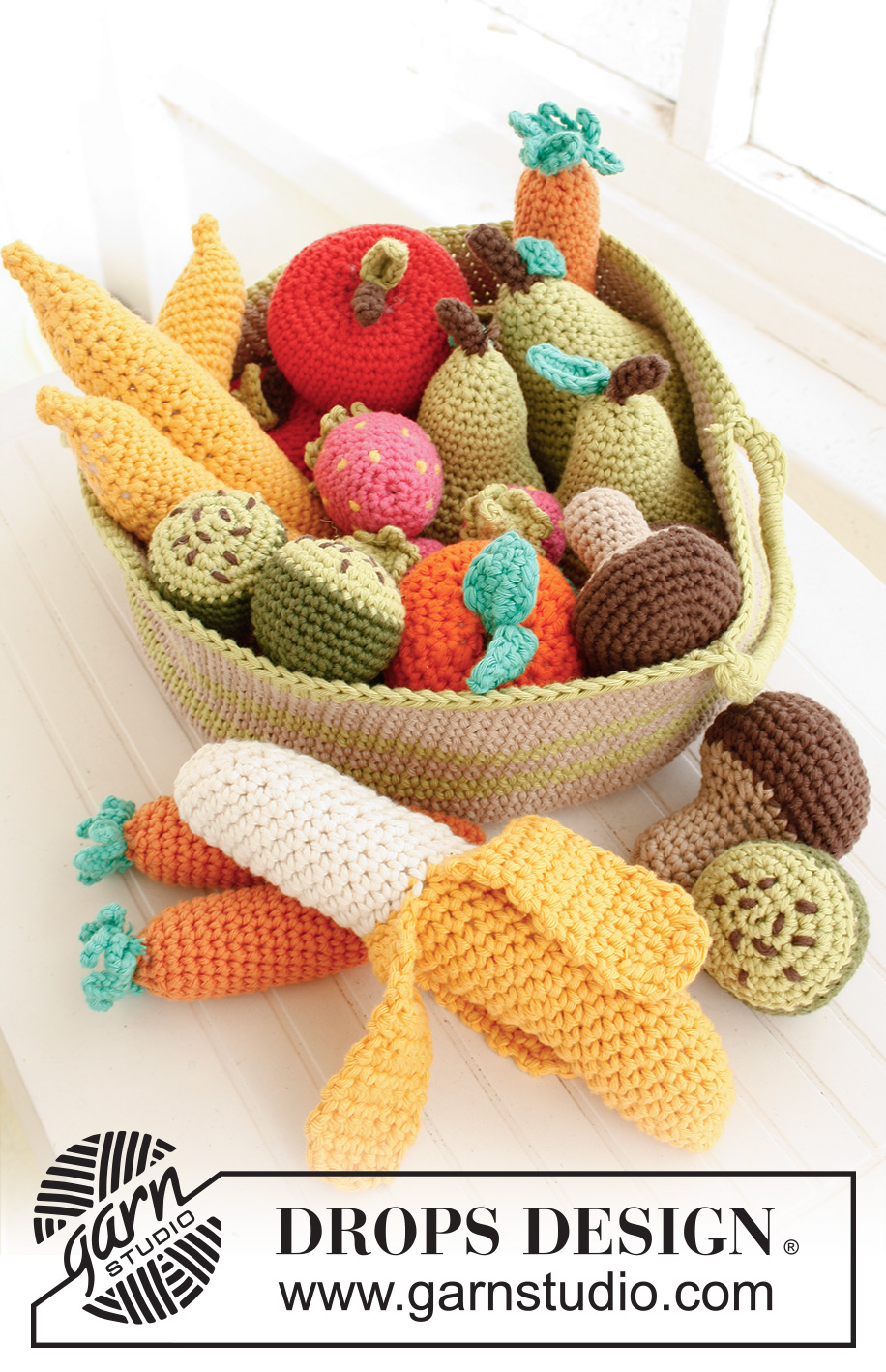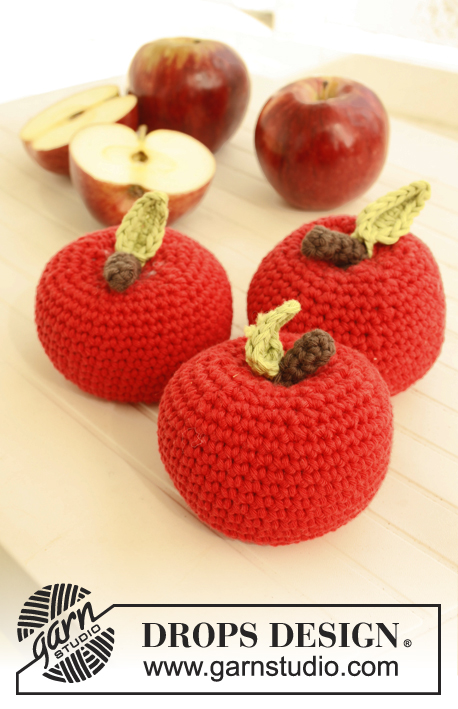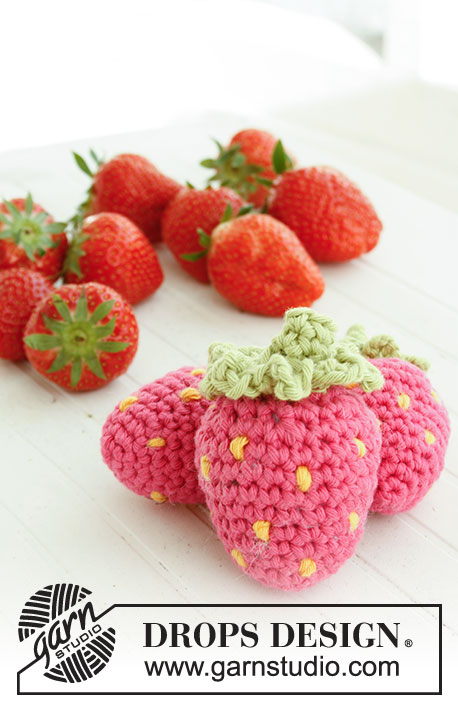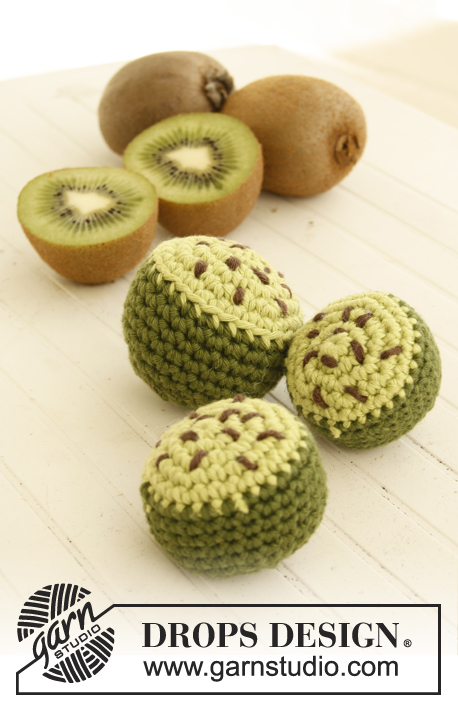Comments / Questions (11)
![]() Loes wrote:
Loes wrote:
De uitleg is prachtig. ik heb nog nooit een 3d ding gehaakt, en dit is heel geschikt om mee te beginnen.
07.07.2024 - 12:25
![]() Valerie M wrote:
Valerie M wrote:
Bonjour je vais me lancer dans la confection du panier fruits et légumes; Je voudrais savoir quelle est environ la taille des différents éléments comme par exemple la poire ? Je ne sais pas si c'est mentionné dans les explications ? merci pour votre réponse Bonne journée
24.05.2019 - 07:58DROPS Design answered:
Bonjour Valérie, nous n'avons pas ces indications, toutefois, sur la base du nombre de mailles, la poire fera environ 23 cm de circonférence au plus large, sur la base de l'échantillon indiqué - soit environ 7 cm de diamètre. Bon crochet!
24.05.2019 - 08:31
![]() Paola wrote:
Paola wrote:
Muchas gracias por compartir. Es muy bueno que se pueda cambiar el idioma, para poder hacer los trabajos. Gracias
18.04.2019 - 23:56
![]() Ingmari wrote:
Ingmari wrote:
Jag förstår inte hur man virkar stjälken till päronet och äpplet. När man har 4 fm enligt beskrivningen och sen ska virka 16 fm med 1 fm i varje fm får jag det inte att gå ihop. Hur ska jag kunna virka 16 fm med 1 fm i varje fm när jag bara har 4 fm? Hälsningar Ingmari
22.03.2019 - 17:46DROPS Design answered:
Hej, du ska virka 1 fast maska i varje fast maska tills du har virkat totalt 16 fasta maskor.
25.03.2019 - 17:27
![]() Maria D wrote:
Maria D wrote:
Gibt es eine Möglichkeit die Birne zu vergrößern? Ich bin auf der Suche nach einer Anleitung für eine Birne mit einem Durchmesser von ca 25cm.
13.03.2019 - 14:02DROPS Design answered:
Liebe Maria, wir können leider nicht jeder Anleitung nach jeder Anfrage anpassen, aber wie wäre es, wenn Sie mit 2 oder 3 Fäden Paris und die passende Häkelnadel häkeln? (beachten Sie nur, daß die Arbeit etwas fest sein muss). Viel Spaß beim häkeln!
13.03.2019 - 15:11
![]() Evi wrote:
Evi wrote:
Help ivm steeltje ; hoe kom je van 4 v naar 16 v ? 🤔 Moet je dan telkens in de 1e en 2e , 2 v maken ? Heb al van alles geprobeerd , maar lukt niet 😥 Grts Evi
16.01.2019 - 23:32DROPS Design answered:
Dag Evi,,/p>
Je haakt eerst 3 lossen en dan haak je a.h.w. in de rondte om die lossen heen, dus i.p.v. dat je toeren heen en weer haakt, haak je aan de bovenkant en onderkant van de lossen en zo ga je in de rondte met steeds 2 vasten in 1 steek.
17.01.2019 - 09:32
![]() Eve wrote:
Eve wrote:
Ich finde diese Anleitung sowie alle anderen toll; Danke dafür....und : die Anleitung ist korrekt so, habe selbst ausprobiert
18.04.2015 - 20:58
![]() Claudia wrote:
Claudia wrote:
Fortsetzung: In meinem ersten Kommentar habe ich die korrigierten Abnahmen aufgeschrieben.
03.12.2013 - 18:58
![]() Claudia wrote:
Claudia wrote:
Am Ende der 7. Rd habe ich 42 M. Wenn ich dann in Rd 14 1 fM in die nächsten 4 fm häkle und dann 1 M abnehme, geht das am Ende der Rd nicht auf. Laut Anleitung sollen dann 35M vorhanden sein (also 7M abgenommen). Das funktioniert aber nur, wenn man in Rd 14 1 fM in die nächsten 5 fM häkelt und dann eine M abnimmt. Nimmt man die Abnahmen so vor, wie Sie es beschrieben haben, dann nimmt man insgesamt 8 M ab und am Ende der Rd bleiben 2 übrig. Das setzt sich in den kommenden Reihen fort.
03.12.2013 - 18:58DROPS Design answered:
Liebe Claudia, die Anleitung ist korrekt: Sie haben 42 M und der Abnahme-Rapport geht über 6 M (4 fM und dann 2 fM zusammenhäkeln). Also 42 M geteilt durch 6 = 7 x , also 7 Abnahmen und 35 M übrig.
04.12.2013 - 07:54
![]() Claudia wrote:
Claudia wrote:
Meiner Meinung nach stimmen die Abnahmen nicht: 14. Rd: 1fm in die nä 5 fm, 1 M abnehmen (= 35 M) 15. Rd: 1fm in die nä 4 fm, 1 M abn (= 28 M) 16. Rd: 1fm in die nä 6 fm, 1 M abn (= 24 M) 23. Rd: 1 fm in die nä 3 fm, 1 M abn (= 18 M) 25. Rd: 1 fm in die nä 2 fm, 1 M abn (= 12 M)
02.12.2013 - 11:50DROPS Design answered:
Liebe Claudia, bitte schreiben Sie uns, an welcher Stelle Sie den Fehler vermuten. Auf den ersten Blick sieht für mich alles korrekt aus.
03.12.2013 - 15:51
Belle Hele#dropsbellehele |
|
 |
 |
Crochet toy pear in DROPS Paris.
DROPS Children 23-61 |
|
|
MAGIC CIRCLE: When piece is worked in the round, start with this technique to avoid holes in the middle (instead of ch-ring): Hold the yarn end and wind the yarn one time around the index finger to make a loop. Hold the loop with left thumb and middle finger, place the thread over left index finger. Insert hook through the loop, make a YO and pull thread through loop, work ch 1, then work sc around the loop. When the desired no of sc have been reached, pull the yarn end to tighten the loop. Fasten the yarn end at the back. Continue to work in the round in a circle. WORK IN THE ROUND IN A CIRCLE: After last sc on the round, continue to next round with 1 sc in next sc (= first sc from previous round). NOTE: Insert a marker at the beg of round between last sc and first sc on the round, move the marker upwards when working. INCREASE TIP: Inc 1 sc by working 2 sc in next sc. DECREASE TIP: Dec 1 sc by working 2 sc tog as follows: * Insert hook in next sc, get thread *, repeat from *-* one more time, make a YO and pull thread through all 3 sts on hook. -------------------------------------------------------- PEAR: Worked in the round in a circle. Start by making a MAGIC CIRCLE - read explanation above - at the bottom of pear with pistachio on hook size 4.5 mm / US 7. ROUND 1: Work 7 sc in the magic circle - READ WORK IN THE ROUND IN A CIRCLE. ROUND 2: Inc 1 sc in every sc = 14 sc. ROUND 3: * 1 sc in next sc, inc 1 sc in next sc *, repeat from *-* the entire round = 21 sc. ROUND 4: * 1 sc in each of the next 2 sc, inc 1 sc in next sc *, repeat from *-* the entire round = 28 sc. ROUND 5: * 1 sc in each of the next 3 sc, inc 1 sc in next sc *, repeat from *-* the entire round = 35 sc. ROUND 6: Work 1 sc in every sc. ROUND 7: * 1 sc in each of the next 4 sc, inc 1 sc in next sc *, repeat from *-* the entire round = 42 sc. ROUND 8-13: Work 1 sc in every sc. ROUND 14: * 1 sc in each of the next 4 sc, dec 1 sc *, repeat from *-* the entire round = 35 sc. ROUND 15: * 1 sc in each of the next 3 sc, dec 1 sc *, repeat from *-* the entire round = 28 sc. ROUND 16: * 1 sc in each of the next 5 sc, dec 1 sc *, repeat from *-* the entire round = 24 sc. ROUND 17-22: Work 1 sc in every sc. ROUND 23: * 1 sc in each of the next 2 sc, dec 1 sc *, repeat from *-* the entire round = 18 sc. ROUND 24: Work 1 sc in every sc. ROUND 25: * 1 sc in next sc, dec 1 sc *, repeat from *-* the entire round = 12 sc. ROUND 26: Work 1 sc in every sc. ROUND 27: Work all sc tog 2 by 2 = 6 sc, cut the thread. Fill the pear with some poly stuffing, sew the last 6 sc tog with thread end. STEM: Worked in the round in a circle. With brown ch 3 on hook size 4.5 mm/ US 7, then 2 sc in 1st and 2nd ch = 4 sc. Continue in the round and work a total of 16 sc with 1 sc in every sc, cut and fasten the thread. LEAF: Worked back and forth. Crochet a row with 8 ch and opal green on hook size 4.5 mm/ US 7, then crochet along the ch-row as follows: 1 sl st in 2nd ch from hook, 1 sc in each of the next ch 2, 1 hdc in next ch, 1 dc in each of the next 2 ch, 2 sc in the last ch. Then work on the other side of ch-row as follows: 1 dc in each of the next 2 ch, 1 hdc in next ch, 1 sc in each of the next 2 ch, 1 sl st in the last ch, cut and fasten the thread. ASSEMBLY: Sew stem and leaf at the top of pear. |
|
Have you finished this pattern?Tag your pictures with #dropspattern #dropsbellehele or submit them to the #dropsfan gallery. Do you need help with this pattern?You'll find 9 tutorial videos, a Comments/Questions area and more by visiting the pattern on garnstudio.com. © 1982-2025 DROPS Design A/S. We reserve all rights. This document, including all its sub-sections, has copyrights. Read more about what you can do with our patterns at the bottom of each pattern on our site. |
|














































Post a comment to pattern DROPS Children 23-61
We would love to hear what you have to say about this pattern!
If you want to leave a question, please make sure you select the correct category in the form below, to speed up the answering process. Required fields are marked *.